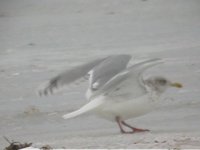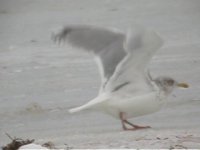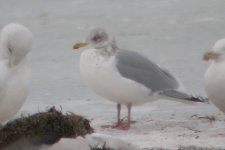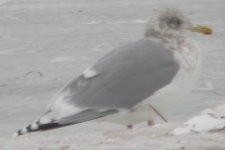Hi Michael and others,
There is a great paper , originally published in one of the Ontario naturalists' journals, by Ron Pittaway, (unfortunately not on the web) detailing the taxonomic history of "Thayer's Gull". Some of the highlights include the fact that the AOU still list Thayer's Gull as a distinct species - therefore it matters to birders who keep lists of species seen. However, there are several reviews, including one in Godfrey's Birds of Canada, and Ron Pittaway's, that suggest that this should not be the case. When first described, L. thayeri was thought to be a subspecies of Herring Gull, and that L. kumlienii was a hybrid between this and Iceland Gulls. Then some research reported in 1966 in the Canadian arctic showed that Thayer's was a separate species, and based upon that, the AOU "split" it from the others. However, this research was subsequently discredited and shown to have reached incorrect conclusions, and more accurate and modern research has shown that L. thayeri, L.glaucoides kumlienii and L. glaucoides glaucoides (the nominate form of Iceland Gull that occurs predominantly in Iceland and N.Europe are probably variations of the same species - which should all be called Iceland Gull as it was the first of the 3 to be properly described.
In another excellent review in Birder's Journal (vol. 7, no.6), Howell summarizes the dilemma for birders, in that there are no consistent differences that separate every kumlienii from every thayeri, in terms of either field observations or museum specimens, and raises some interesting circular arguments, such as "we can't learn how much they interbreed until we can distinguish them and we can't distinguish them until we learn how much they interbreed".
The main discussions now found on the web focus around whether "Iceland gull" has a continuous gradation of some features between pure Iceland at one end of the spectrum and Thayer's at the other end, analogous to, say, Rough-legged Hawks and Song Sparrows, whether they represent true color phases, analogous to "White" and "Blue" Snow Geese, separable subspecies or a combination of all of those!
Maybe there is some way in which the birds themselves can distinguish between these forms, as yet unknown to humans (e.g. has anyone looked at Thayer's and Kumlien's in U-V light?), but otherwise I feel it can only be a matter of time before the AOU "lump" Thayer's and Iceland, and then listers will unfortunately take less of an interest.
If you think this is complex, try looking at some of the literature on the taxonomy of Asiatic "Herring"-type Gulls, then Common/ Hoary/ Arctic/ Mealy Redpolls, or the 7+ possible species of Red Crossbill in N.America alone! Presumably some more definitive answers will come when researchers have enough mitochondrial DNA from recognizable forms of all these species, or whatever they are, on their breeding grounds, to analyze in a statistically meaningful way.
Cheers,








